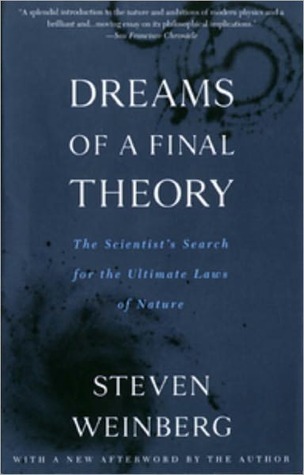More on this book
Kindle Notes & Highlights
Read between
October 26, 2021 - March 29, 2022
Like any other field in a quantum-mechanical theory, this new field that is responsible for electroweak symmetry breaking would have an energy and momentum that come in bundles, known as quanta. The electroweak theory tells us that at least one of these quanta should be observable as a new elementary particle. Several years before Salam and I developed a theory of weak and electromagnetic forces based on spontaneous symmetry breaking, the mathematics of simpler examples of this sort of symmetry breaking had been described by a number of theorists, most clearly in 1964 by Peter Higgs of the
...more
In the original version of the standard model, the Higgs particle is the only particle whose mass appears directly in the equations of the theory; the breaking of the electroweak symmetry gives all the other particles masses that are proportional to the Higgs particle mass. But we have no evidence that matters are so simple.
We know that there is a broken symmetry between the weak and electromagnetic forces because the theory that is based on this symmetry works—it makes a large number of successful predictions about the properties of the W and Z particles and about the forces they transmit. But we are not actually sure that the electroweak symmetry is broken by the vacuum value of some field in the theory or that there is a Higgs particle. Something has to be included in the electroweak theory to break this symmetry, but it is possible that the breakdown of the electroweak symmetry is due to indirect effects of
...more
There was an obvious obstacle to any sort of unification along these lines. The apparent strengths of the forces in any field theory depend on two kinds of numerical parameter: the masses (if any) of the particles like W and Z particles that transmit the forces, and certain intrinsic strengths (also known as coupling constants) that characterize the likelihood for particles like photons or gluons or W and Z particles to be emitted and reabsorbed in particle reactions. The masses arise from spontaneous symmetry breaking, but the intrinsic strengths are numbers that appear in the underlying
...more
If there really were some spontaneously broken symmetry that linked the strong and electroweak forces, then there would have to exist new heavy particles in order to fill out the complete family of force-carrying particles along with the W, Z, photon, and gluons. In this case, the energy of a few million billion billion volts could be identified as the energy contained in the mass of these new heavy particles. As we shall see, in today’s superstring theories there is no need to assume the existence of a separate new symmetry linking the strong and electroweak forces, but it is still the case
...more
The value of the Planck energy confronts us with a formidable new problem. It is not that this energy is so large—it arises in physics at such a deep level that we can suppose that the Planck energy is simply the fundamental unit of energy that appears in the equations of the final theory. The mystery is why are all the other energies so small? In particular, in the original version of the standard model the masses of the electron and the W and Z particles and all the quarks are proportional to the one mass that appears in the equations of the model, the mass of the Higgs particle. From what
...more
As a result of this reappraisal of the problem of infinities, we now think that the field equations of the standard model are not of the very simple type that would be renormalizable but that they actually contain every conceivable term that is consistent with the symmetries of the theory. But then we must explain why the old renormalizable quantum field theories like the simplest versions of quantum electrodynamics or the standard model worked so well. The reason, we think, can be traced to the fact that all the terms in the field equations, apart from the very simple renormalizable terms,
...more
It is the conservation of quark and lepton number that prevents processes like the decay of the three quarks in a proton into a positron and a photon, and thus it is this conservation law that ensures the stability of ordinary matter. But we now think that the complicated nonrenormalizable terms in the field equations that could violate the conservation of quark and lepton number are really present but just very small. These small terms in the field equations would make the proton decay (e.g., into a positron and a photon or some other neutral particle), but with a very long average lifetime,
...more
Meanwhile there have lately been intriguing hints of a possible violation of the conservation of lepton number. In the standard model this conservation law is responsible for keeping the neutrinos massless, and with this conservation law violated we would expect neutrinos to have small masses, about a hundredth to a thousandth of a volt (or in other words, about one billionth the mass of an electron). This mass is much too small to have been noticed in any laboratory experiment done so far, but it could have a subtle effect, of allowing neutrinos that start out as electron-type neutrinos
...more


